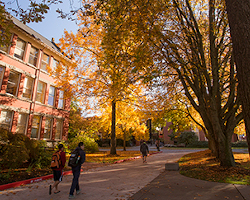 April in Oregon is an exciting time of the year, complete with wild weather, bursting blossoms, and frolicking ducks and geese. The whole natural world awakens with new growth and new life. As thrilling as this revitalization is, April is exciting for another important reason–it’s National Poetry Month! In 1996, the Academy of American Poetry (AAP) proclaimed April as National Poetry Month and poetry lovers have been celebrating this month ever since. According to AAP, their goals for the month include an effort to “highlight the extraordinary legacy and ongoing achievement of American poets” and “encourage the reading of poems.” So while you’re out appreciating the wonders of spring, why not take a moment to appreciate the wonders of poetry? Take a look at our WU Reads Reading Guide for a selection of current volumes of poetry in our collection.
April in Oregon is an exciting time of the year, complete with wild weather, bursting blossoms, and frolicking ducks and geese. The whole natural world awakens with new growth and new life. As thrilling as this revitalization is, April is exciting for another important reason–it’s National Poetry Month! In 1996, the Academy of American Poetry (AAP) proclaimed April as National Poetry Month and poetry lovers have been celebrating this month ever since. According to AAP, their goals for the month include an effort to “highlight the extraordinary legacy and ongoing achievement of American poets” and “encourage the reading of poems.” So while you’re out appreciating the wonders of spring, why not take a moment to appreciate the wonders of poetry? Take a look at our WU Reads Reading Guide for a selection of current volumes of poetry in our collection.
Poetry is language at its most distilled and most powerful. — Rita Dove
Poetry has never been the language of barriers, it’s always been the language of bridges. — Amanda Gorman
For more information about National Poetry Month visit: https://poets.org/national-poetry-month

 The big celebration in February is Valentine’s Day but did you know there is another huge cause for celebration? February is Library Lovers’ Month—a whole month dedicated to celebrating the place that so many of us hold near and dear to our heart! Libraries are spaces devoted to many wonderful concepts such as cultural preservation, freedom of information, and lifelong learning. They provide access to great collections of books, journals, video recordings, archival treasures, and more. Libraries also offer a place for people to socialize, work together on projects, and enjoy special exhibits; they provide a quiet, safe space for reflection and for community. Some libraries, like the Hatfield Library, extend access to unexpected things such as jigsaw puzzles, craft materials, home improvement items, and much more. And, of course, libraries offer intelligent, dedicated staff, ready to help you! Join us this month in celebrating all the great libraries out there—past, present and future!
The big celebration in February is Valentine’s Day but did you know there is another huge cause for celebration? February is Library Lovers’ Month—a whole month dedicated to celebrating the place that so many of us hold near and dear to our heart! Libraries are spaces devoted to many wonderful concepts such as cultural preservation, freedom of information, and lifelong learning. They provide access to great collections of books, journals, video recordings, archival treasures, and more. Libraries also offer a place for people to socialize, work together on projects, and enjoy special exhibits; they provide a quiet, safe space for reflection and for community. Some libraries, like the Hatfield Library, extend access to unexpected things such as jigsaw puzzles, craft materials, home improvement items, and much more. And, of course, libraries offer intelligent, dedicated staff, ready to help you! Join us this month in celebrating all the great libraries out there—past, present and future! This month brings us the joy of winter break and various holidays–many of us will be gathering with family and friends for delicious homecooked meals and tasty sweet treats. There is something magical about cooking and baking in a warm, cozy kitchen when the weather outside is frightful. It doesn’t matter if we are making a new recipe or a traditional family favorite, sharing our scrumptious creations with our loved ones is a highlight of the season. Whether you’re a veteran chef or a novice baker, why not find out more about cooking and baking with one of these books from the library’s collection featured on the
This month brings us the joy of winter break and various holidays–many of us will be gathering with family and friends for delicious homecooked meals and tasty sweet treats. There is something magical about cooking and baking in a warm, cozy kitchen when the weather outside is frightful. It doesn’t matter if we are making a new recipe or a traditional family favorite, sharing our scrumptious creations with our loved ones is a highlight of the season. Whether you’re a veteran chef or a novice baker, why not find out more about cooking and baking with one of these books from the library’s collection featured on the  The weather is getting colder and the days are getting shorter and many of us relish the opportunity to stay inside with a good book and a hot beverage of our choice. This time of year, we look forward to Fall break, a few days off, good food, and some time with family and friends. But the unhoused or homeless experience is very different as they struggle to stay warm, dry, fed, and hopeful. Did you know 5 percent of homeless people in the United States are unaccompanied youth under 25? And Oregon has one of the highest rates of homelessness in the country. November is National Youth Homelessness Awareness Month so take some time to learn more by taking a look at some of these books from the library’s collection featured on the
The weather is getting colder and the days are getting shorter and many of us relish the opportunity to stay inside with a good book and a hot beverage of our choice. This time of year, we look forward to Fall break, a few days off, good food, and some time with family and friends. But the unhoused or homeless experience is very different as they struggle to stay warm, dry, fed, and hopeful. Did you know 5 percent of homeless people in the United States are unaccompanied youth under 25? And Oregon has one of the highest rates of homelessness in the country. November is National Youth Homelessness Awareness Month so take some time to learn more by taking a look at some of these books from the library’s collection featured on the  For many of us, October brings to mind autumn leaves, jack o’ lanterns, pumpkin everything, scary costumes, and cooler weather. But October is also American Archives Month and it is only fitting for us to pay tribute to all the fabulous Archives around the country including our very own University Archives! If you’ve never visited Willamette’s archive, now is the time—with four major collecting areas including University archives and records, political papers, personal collections, and the Pacific Northwest Artist Archive, there is bound to be something of interest to everyone. The archives includes papers, publications, photographs, diaries, correspondence, scrapbooks, memorabilia, and much more. Our dedicated archives staff (including our great student interns), works diligently every day to organize, describe, preserve, manage, and share our wonderful collections. Archives play a crucial role in preserving history, telling stories, and helping us understand our past and its link to the present. So a big shout out to archivists and archives everywhere. And checkout some of the interesting archives-related books from the library’s collection featured on the
For many of us, October brings to mind autumn leaves, jack o’ lanterns, pumpkin everything, scary costumes, and cooler weather. But October is also American Archives Month and it is only fitting for us to pay tribute to all the fabulous Archives around the country including our very own University Archives! If you’ve never visited Willamette’s archive, now is the time—with four major collecting areas including University archives and records, political papers, personal collections, and the Pacific Northwest Artist Archive, there is bound to be something of interest to everyone. The archives includes papers, publications, photographs, diaries, correspondence, scrapbooks, memorabilia, and much more. Our dedicated archives staff (including our great student interns), works diligently every day to organize, describe, preserve, manage, and share our wonderful collections. Archives play a crucial role in preserving history, telling stories, and helping us understand our past and its link to the present. So a big shout out to archivists and archives everywhere. And checkout some of the interesting archives-related books from the library’s collection featured on the  The beginning of a new academic year is an exhilarating time for students and faculty alike. Whether you’re new or returning, walking onto campus at the beginning of a new school year can inspire a whole lot of different emotions—enthusiasm, excitement, and delight all mix together with a little trepidation, confusion, and worry. This time of year, spirits are high as the entire community anticipates gathering together in a common space for teaching, learning, research, growth, fun, camaraderie, and so much more. Although the start of the new school year can feel chaotic at times, it also offers new beginnings and all sorts of new possibilities. As we head into academic year 2023-24, why not explore the wonderful world of college through fictional accounts such as the ones listed on our
The beginning of a new academic year is an exhilarating time for students and faculty alike. Whether you’re new or returning, walking onto campus at the beginning of a new school year can inspire a whole lot of different emotions—enthusiasm, excitement, and delight all mix together with a little trepidation, confusion, and worry. This time of year, spirits are high as the entire community anticipates gathering together in a common space for teaching, learning, research, growth, fun, camaraderie, and so much more. Although the start of the new school year can feel chaotic at times, it also offers new beginnings and all sorts of new possibilities. As we head into academic year 2023-24, why not explore the wonderful world of college through fictional accounts such as the ones listed on our  Pride Month is celebrated each year in June to honor the Stonewall Riots or Uprising that took place in 1969 in New York City to protest the police raid of a gay club called the Stonewall Inn. This spontaneous protest is acknowledged by many as the catalyst for the gay rights movement. According to the Encyclopedia Britannica, Gay Pride or LGBTQ+ Pride Month “commemorates years of struggle for civil rights and the ongoing pursuit of equal justice under the law for the lesbian, gay, bisexual, transgender, and queer community, as well as the accomplishments of LGBTQ individuals.” All across the nation and the world, celebrations take place to honor the fight for equal rights and the many contributions of the LGBTQ+ community; events include pride parades, picnics, parties, concerts, workshops, and more. During this month, memorials are also held in remembrance of those who have been lost to hate crimes or HIV/AIDS. Given the current political and societal battles over a variety of LGBTQ+ issues and rights, it seems that it is more important than ever to recognize Pride Month. So join us in celebration and check out recent LGBTQ+ sources from our collection on our
Pride Month is celebrated each year in June to honor the Stonewall Riots or Uprising that took place in 1969 in New York City to protest the police raid of a gay club called the Stonewall Inn. This spontaneous protest is acknowledged by many as the catalyst for the gay rights movement. According to the Encyclopedia Britannica, Gay Pride or LGBTQ+ Pride Month “commemorates years of struggle for civil rights and the ongoing pursuit of equal justice under the law for the lesbian, gay, bisexual, transgender, and queer community, as well as the accomplishments of LGBTQ individuals.” All across the nation and the world, celebrations take place to honor the fight for equal rights and the many contributions of the LGBTQ+ community; events include pride parades, picnics, parties, concerts, workshops, and more. During this month, memorials are also held in remembrance of those who have been lost to hate crimes or HIV/AIDS. Given the current political and societal battles over a variety of LGBTQ+ issues and rights, it seems that it is more important than ever to recognize Pride Month. So join us in celebration and check out recent LGBTQ+ sources from our collection on our  Warmer weather, longer hours of daylight, beautiful flowering plants and leafing out trees—it’s the perfect time of year to get outside and go for a walk. And if you need a little additional incentive, May is National Walking Month! Walking is a great form of exercise for most people—you don’t need any equipment beyond decent shoes, you don’t need to be a part of a team to participate, and you don’t need to be athletically gifted. It’s just so easy—you just put on your shoes and walk out the door!
Warmer weather, longer hours of daylight, beautiful flowering plants and leafing out trees—it’s the perfect time of year to get outside and go for a walk. And if you need a little additional incentive, May is National Walking Month! Walking is a great form of exercise for most people—you don’t need any equipment beyond decent shoes, you don’t need to be a part of a team to participate, and you don’t need to be athletically gifted. It’s just so easy—you just put on your shoes and walk out the door! If you are a student and have written and researched an excellent paper, consider submitting your paper for consideration for the Excellence in Research Award. Faculty, please encourage your best student writers/researchers to apply.
If you are a student and have written and researched an excellent paper, consider submitting your paper for consideration for the Excellence in Research Award. Faculty, please encourage your best student writers/researchers to apply. Although we may not want to admit it, a whole lot of us spend a fair amount of time watching silly cat videos or sitcoms. We love the bloopers at the end of movies or we pretend we’re reading the newspaper for the news but we’re really looking at the cartoons. Well, that’s okay because it turns out that laughter is a wonderful stress relief! According to staff at the Mayo Clinic, laughter has lots of short-term benefits (soothes tension, stimulates heart, lungs, and muscles, etc.) as well as long-term benefits (improves immune system, relieves pain, helps lessen depression, etc.). And now is the perfect time to smile, giggle, and laugh out loud because April is National Humor Month! With the end of the semester looming, all of us could probably benefit from a good laugh so check out the humor-related books on our
Although we may not want to admit it, a whole lot of us spend a fair amount of time watching silly cat videos or sitcoms. We love the bloopers at the end of movies or we pretend we’re reading the newspaper for the news but we’re really looking at the cartoons. Well, that’s okay because it turns out that laughter is a wonderful stress relief! According to staff at the Mayo Clinic, laughter has lots of short-term benefits (soothes tension, stimulates heart, lungs, and muscles, etc.) as well as long-term benefits (improves immune system, relieves pain, helps lessen depression, etc.). And now is the perfect time to smile, giggle, and laugh out loud because April is National Humor Month! With the end of the semester looming, all of us could probably benefit from a good laugh so check out the humor-related books on our